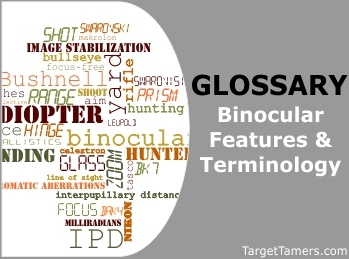
To make your best binocular buy yet, you've got to be able to comprehend all the jargon.
If you're a newbie and you're jumping in head first into binoculars, then here's a glossary that just barely scratches the surface.
But, if you've been using binoculars for longer than these youngin's have been alive, then I guess this is just a refresher for you.
Binoculars Features & Terminology
A | B | C | D | E | F | G | H | I | J | K | L | M | N | O | P | Q | R | S | T | U | V | W | X | Y | Z
A
Abbe-König - This is a variation of the roof prism assembly. It has the same fundamental functions and structure of a roof prism, but light takes a slightly different course through the assembly. (See also our Roof Vs Porro Prism article; see also Roof Prisms.)
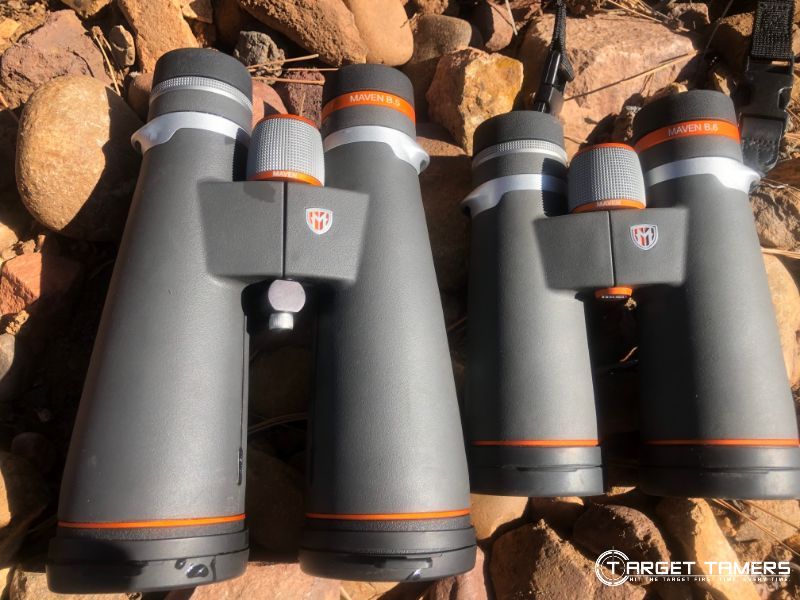
Adjustable Eyepiece - Also known as the diopter, its purpose is to eliminate the effects of varying eye strengths for each eye. It should have some sort of scale marked on the underside, such as "-0+" with another marking so that you can easily reference it. (See also Diopter; see also our How to Adjust Binoculars article.)
ArmorTek - This is Vortex's external coating that provides hardness and scratch-resistance for ultimate lens protection and easy cleaning.
Auto Focus - This term is a misnomer. However, it's often used as another name for Individual Focus Systems despite the fact that there is no internal mechanism that adjusts for focus automatically. (See also Individual Focus Systems; see also our How to Focus Binoculars article.)
B
B - This was a previously used designation to indicate Zeiss binoculars that were appropriate for glasses-wearers. However, it's no longer used since Zeiss now manufactures their binoculars for glasses-wearers and non-glasses wearers alike.
BAK4 - This term is a designation by Schott AG that stands for BaritleichKron - Barium Crown in German. Barium is a type of crown glass, and it's highly reflective with a refractive index rate of 1.5688 and is used to make the prisms for binoculars. (See also Prisms)
Barrels - These are the tube-like telescopes that are connected together by a bridge to form a binocular.
BK7 - A term designated by Schott AG and is used to make the prisms for binoculars. It's made out of borosilicate (crown) glass, and it's highly reflective with a refractive index rate of 1.5168. (See also Prisms.)
C
Center Focus - This is the wheel or knob that's found in the center of the bridge and is used focus the binocular and correct for varying eye strengths in the left eyepiece.
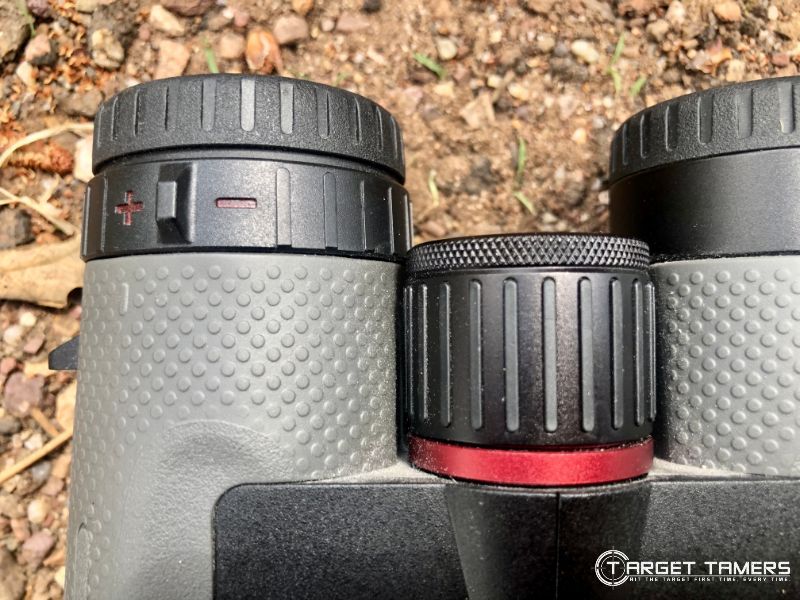
Chinese BAK4 - Made out of phosphate crown glass with a refractive index rate of 1.5525 and is used to make the prisms for binoculars. Because many optics companies outsource their binocular manufacturing while still requiring very strict quality control measures to be met, binoculars with Chinese BAK4 prism glass are often more affordable than "real" Schott BAK4. (See also Prisms.)
Chromatic Aberrations - A form of image distortion also known as color fringing. The edges of objects may be blurry, color tinted, and fuzzy.
ClicLoc System - This is Steiner's take on the "quick release" system that's incorporated in many optics brands neck straps for fast and easy access to the binocular. Either the neck strap or the harness are equipped with convenient parts that allow the binoculars to be attached and released with the push of a button.
Coatings – Special chemical coatings are applied to the lens of an optic to improve light transmission. These coatings are categorized as coated, fully-coated, multi-coated, and fully multi-coated. More coatings can mean less glare, reflectivity, and a better, brighter, and crisper image.
Color Fringing - Effect of chromatic aberrations. (See also Chromatic Aberrations.)
Comfort Focus Concept - All of Zeiss' Victory HT binoculars are built for comfortable use while glassing for hours. Thumb indents, center focus location, and the overall, ergonomic construction are built for comfort.
D
Dielectric - This is a specially formulated prism coating that increases the reflectivity of the prism surface. It's more efficient than silver or magnesium based mirror coatings.
Diopter - This is also known as an adjustable eyepiece. (See also Adjustable Eyepiece.)
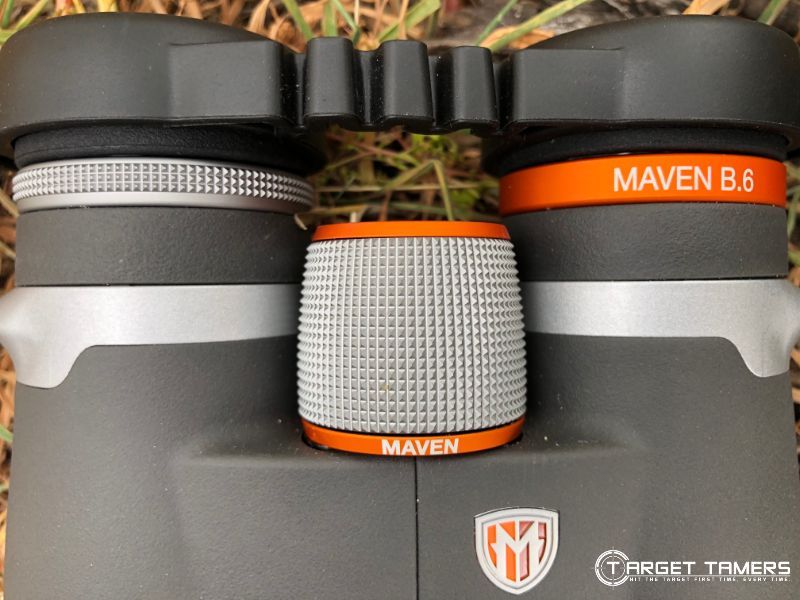
Dispersion - This refers to light-wave activity once it makes contact with binocular glass and how it behaves inside the optical pathway. Special glass elements like ED glass keep light-waves in-phase and from scattering within the optical pathway. (See also ED Glass.)
Double Hinge - This is a binocular design where a hinge on each side of the barrel connects to the bridge to appropriately adjust for IPD.
E
Eco-Glass - Environmentally-friendly glass that's been made without lead or arsenic.
ED Glass - Extra low Dispersion. Elements in the glass prevent light-waves from scattering by keeping them in phase of each other. This results in low chromatic aberrations and may also produce an HD image.
Exit Pupil - The size of the beam of light seen in the eyepiece of the binocular when held up in bright conditions. This also indicates how much light may be accessible to you during the day and low light.
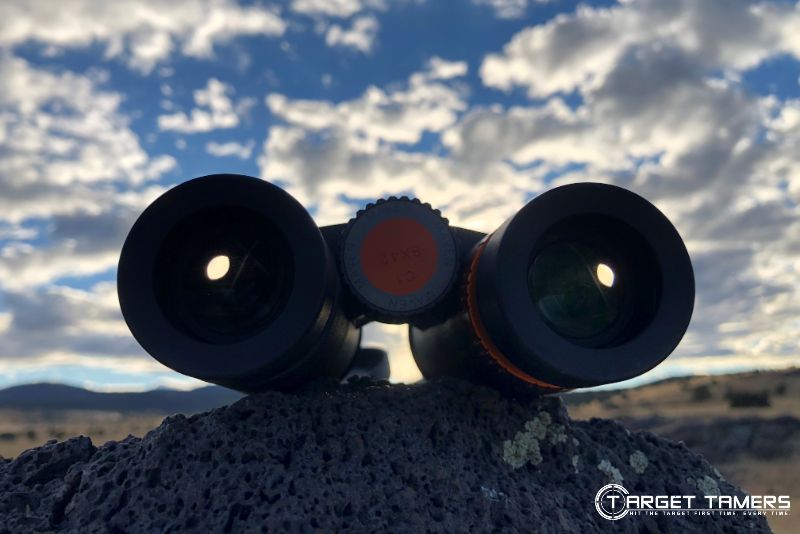
Eyecups - Typically made out of plastic, sometimes metal, and then covered in rubber to help achieve the appropriate amount of eye relief and to provide some comfort when the eyepiece touches the brow and eye sockets. (See also our How to Adjust Binoculars article.)
Eye Relief - The distance from your pupil to the ocular lens while still seeing the entire field of view. (See also our How to Focus Binoculars article.) The Outland X 10X42 Binocular by Celestron has a short 14mm eye relief.
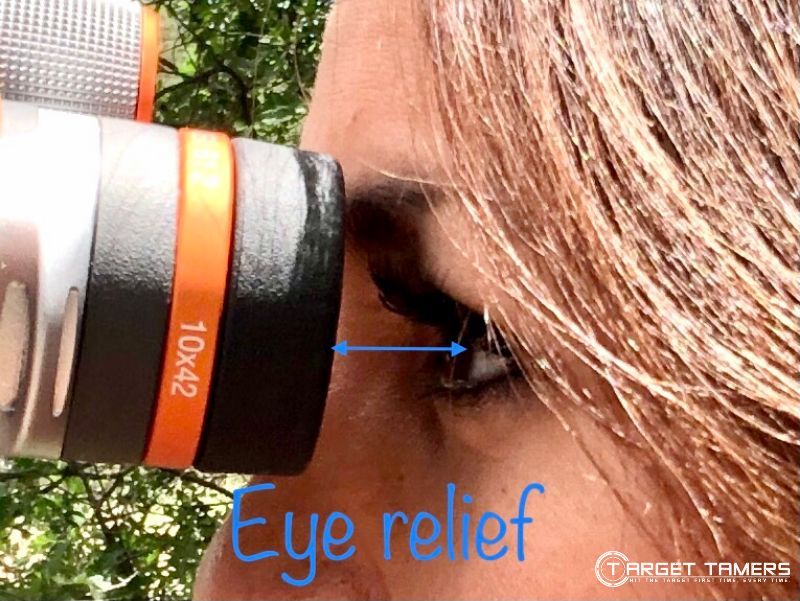
F
Fast Focus Technology - Steiner's center focus technology where it takes less revolutions to zoom in from close focus to long distance.
Field of View - The edge to edge view of the entire image measured in feet when glassing at 1000 yards.
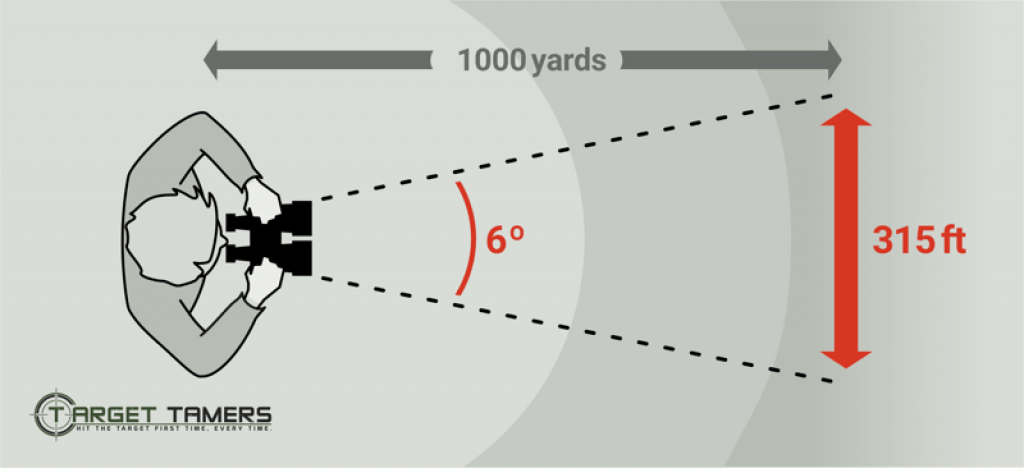
Fixed Focus - A binocular that is fixed for a specific distance, and it can't be adjusted to calibrate for varying eye strengths. Also known as Focus-Free and No-Focus binoculars.
Fixed Power – The permanent magnification is factory set at a specific zoom and doesn't have zooming capabilities.
FL - This is Zeiss' designation for glass that contains fluoride (FL) for sharper, higher contrast images to reduce chromatic aberrations. (See also Chromatic Aberrations.)
Focus-Free - Also known as Fixed Focus and No-Focus binoculars. (See also Fixed Focus.)
Fold Up Eyecups - A rubber eyecup that folds down to lengthen eye relief for glasses-wearers and remains up for use with the naked eye. (See also Eyecups.)
H
HD - High Definition. Mistakenly, people think it's a type of lens. Instead, it's a direct result of very good resolution from ED glass.
High Contrast Lenses - Steiner's term for their coating technology that prevents chromatic aberrations due to out-of-phase light-waves.
HT - High Transmission. Zeiss' term for their Schott glass with excellent transmission properties.
I
iC - Zeiss' designation for optics with illumination control.
Image Stabilization - This is a feature on binoculars that eliminate any apparent movement from the image due to using the binocular free-hand. (See also our 4 Binocular Features to Review Before You Buy article.)
Individual Focus - Focus system that allows for each eyepiece to be focused individually. (See also our How to Focus Binoculars article.)
IPD - Interpupillary Distance. This is the distance from one pupil to the other to create a single image. (See also our How to Focus Binoculars article.)
L
LotuTec - Zeiss' external lens coatings for ultimate lens protection and easy cleaning.
M
Makrolon Housing - Steiner's durable, fiber-reinforced, non-corrosive polycarbonate that's made with latex-free nitrile compounds, NBR, that make up the rubber armoring of the binocular body. It's lightweight, extremely durable, and it's impervious to all types of weather. Steiner was the first optics manufacturer to revamp Makrolon for use in the construction of binoculars in 1967.
MC - Zeiss' term for Multi-Coating. (See also Coatings.)
MeoBright – This is Meopta's fully multi-coated lens formula that produces industry-leading light transmission capacity. (See also Coatings.)
MeoShield – This is Meopta's lens protectant and surface hardener.
Michael Waddell Bone Collector Edition - Bushnell has a special optics edition series named after the TV reality star. The series includes the Trophy XLT 10X42 binocular, the 3-9X40 Bone Collector rifle scope, a Bone Collector's Edition laser rangefinder, and the Bone Collector trail camera.
N
No-Focus - Also known as Fixed Focus and Focus-Free binoculars. (See also Fixed Focus.)
P
P/P* - Zeiss' designation for phase correction coatings on the roof prisms that provides a higher resolution image. (See also Phase Correction Coating.)
PC-3 Phase Coated Prism Coatings - Bushnell's designation for reduced color fringing, increased contrast, and improved color resolution. (See also Phase Correction Coating.)
Phase Correction Coating - This is a special coating that's applied to premium and higher quality roof prism assemblies to rejoin light-waves since they're split in two within the optical path. Consequential light loss, chromatic aberration, decreased color resolution, and reduced contrast will be minimized by forcing light-waves to unite and staying in phase when roof surfaces have been treated with phase correction coatings.
Porro Prisms - This prism system incorporates an optical path that directs light in a Z or zig zag-like pattern. It has offset eyepieces to objective lenses - oculars are closer together and objectives are further apart.
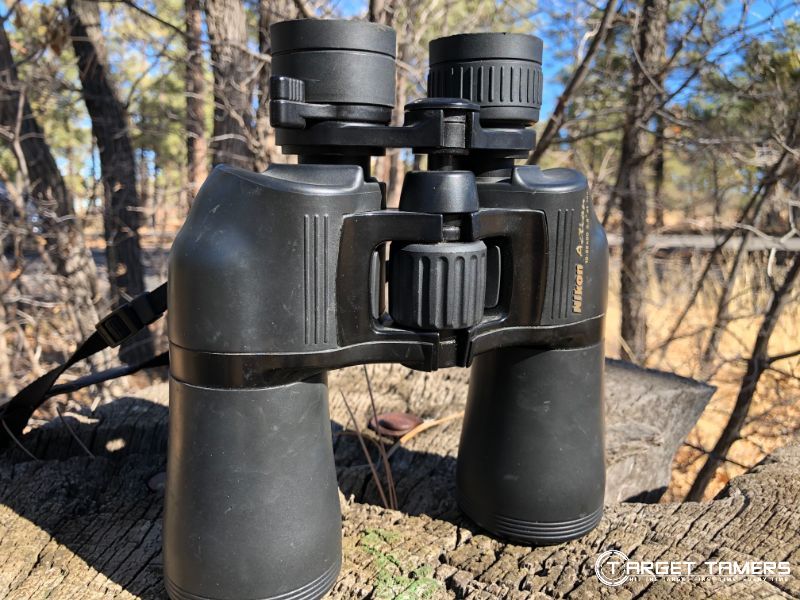
Power – This term is interchangeable with magnification. This indicates the magnification setting or range of the binocular and is known by the "X" that follows a model's number sequence.
Prism Assembly - This is the glass structure that's housed within the binocular that controls and directs light through an optical path from the objective bells to the eyepieces. (See also Porro Prisms; see also Roof Prisms.)
R
Rangefinder Binoculars - Binoculars with an internal laser system that acquires distances to objects when activated. (See also our Features to Review Before Your Next Binocular Purchase article.
Reverse Porro Prisms - This prism system incorporates an optical path that directs light in a Z or zig zag-like pattern. It has offset eyepieces to objective lenses - oculars are further apart and objectives are closer together.
Roof Prisms - This prism system incorporates a straight line optical path that allows binoculars to be made with aligned eyepieces to objective lens construction.
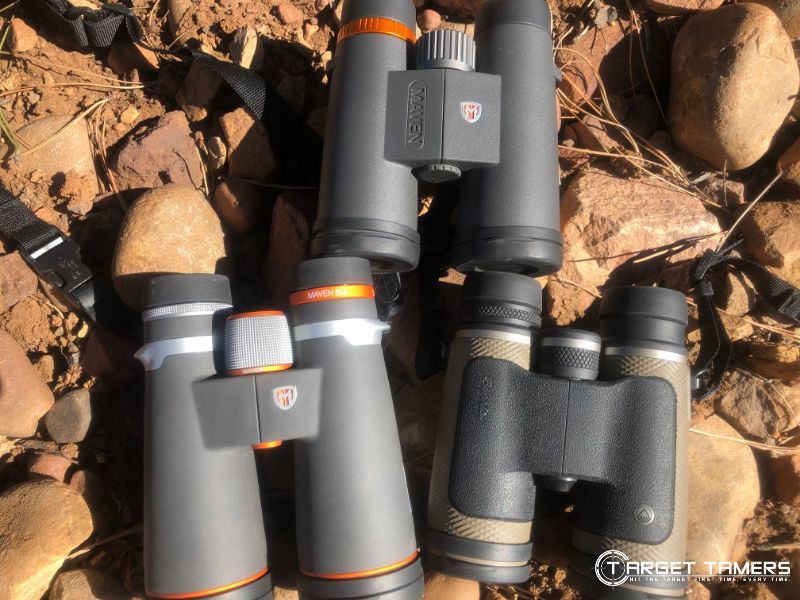
Ruby Coatings - External lens coating to filter out red from the light spectrum to minimize glare, reflections, and haze. (See also our Binocular Features article.)
S
S - Zeiss' designation for binoculars with mechanical image stabilization.
Schmidt-Pechan - This is a high-quality variation of the roof prism design. (See also Roof Prisms.)
Self Focus - This term is a misnomer. However, it's often used as another name for Individual Focus Systems despite the fact that there is no internal mechanism that adjusts for focus automatically. (See also Individual Focus Systems; see also our How to Focus Binoculars article.)
SF - Smart Focus. Zeiss' center focus technology where it takes less revolutions to zoom in from close focus to long distance. According to Zeiss, conventional center focus binoculars require 2.5 revolutions where as their SF binoculars only need to be turned 1.8 times.
Single Hinge - The barrels of the binocular are able to move outward and inward to achieve a correct IPD with the use of a single hinge located in the center of the bridge.
SwaroAim - Swarovski's term for a built-in inclinometer feature to calculate angle compensated distances and angle measurements. This is their laser rangefinding technology.
SwaroBright - This is Swarovski's optics coatings for ultimate light transmission of the full light spectrum for maximum color resolution and fidelity.
SwaroClean - Swarovski's term for their external lens coatings that provides easy lens maintenance and cleaning.
SwaroVision - Swarovski's fluoride-containing Field Flattener lenses that provide HD image quality, minimizes chromatic aberrations, and increases detail-rich depths of fields.
Synergy Built Project - This is Leupold's commitment to provide their buyers with the best binoculars possible. They say it starts with their scientists, engineers, and design developers from glass procurement to packaging. In addition, every outsourced material and in-house processing step has been under strict quality control procedures.
T
T* - This is Zeiss' designation for their multi-layer coatings for extremely high transmission and low reflex susceptibility.
Twist Up Eyecups - Rubber eyecups that twist up to achieve the appropriate amount of eye relief for non-glasses wearers and they retract for non-glasses wearers. They may also have multi-position settings and may also be locked into place. (See also Eyecups.)
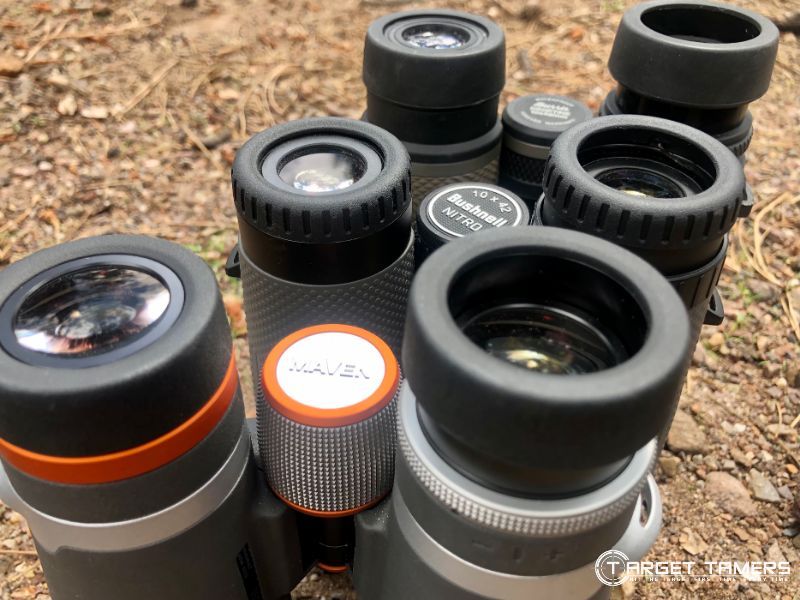
V
Variable Power - Magnification of the binocular isn't fixed. This term is also interchangeable with zoom. Other types of variable power binoculars offer fixed magnifications but with a variety of various fixed magnification eyepieces - eg. 25X/40X power. These are not typically geared towards hunters.
W
Wrap Around Eyecups - Rubber eyecups that are fixed into place and don't retract or pull out. Their unique style has rubber sides that extend into a horn or wrap around design to block out light, periphery sight distractions, wind, and other weather elements. They can't be successfully or comfortably used with glasses since they're intended for use with the naked eyes.
Z
Zoom - Magnification of the binocular isn't fixed and is instead, variable. This term is sometimes interchangeable with variable power. They can zoom from a low power of 6X to as high as 30X. (See also our Binocular Features to Review Before You Buy Your Next Binocular article.
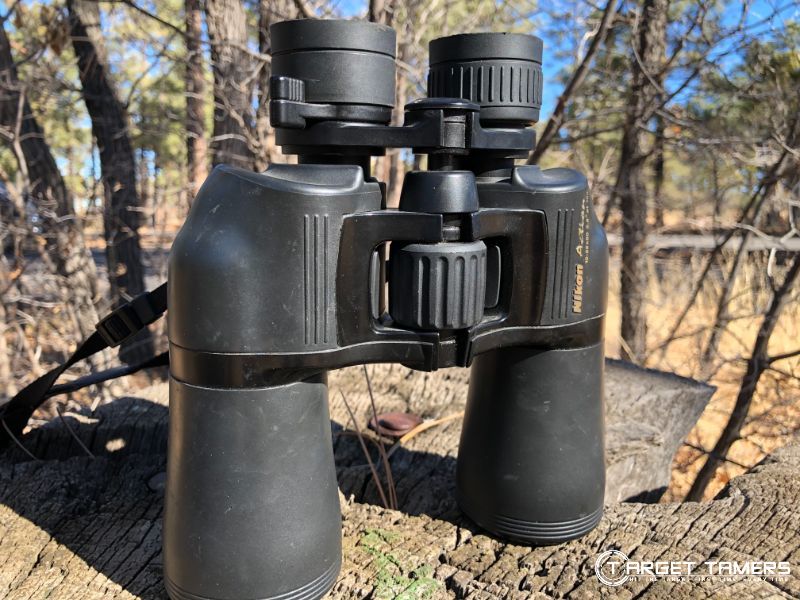
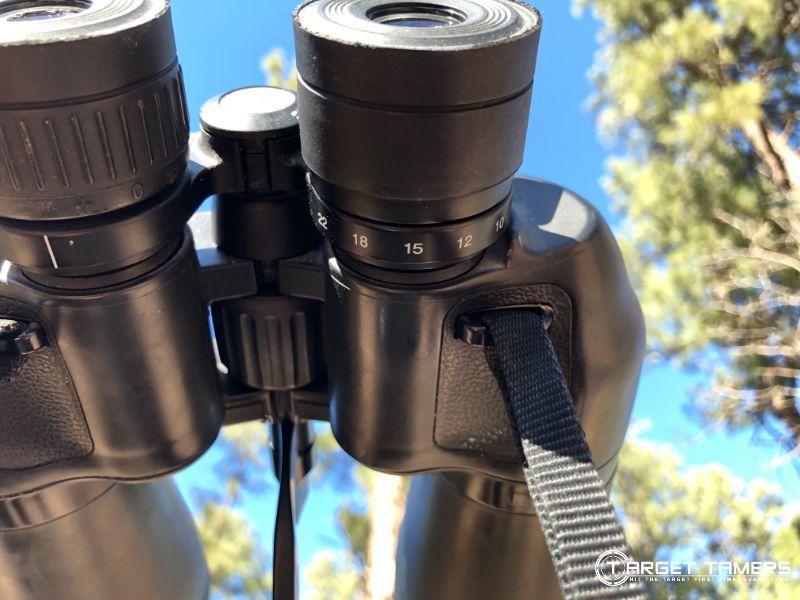
If you think you knew it all when it came to optics terminology, I hope you know better now. For hunters of all levels and of all ilk, you can never be too informed about the many abbreviations, the new marketing terms, and the old-school optics slang.
Now You Know the Lingo, Put it to Use With Our Binocular Reviews
Further Reading
- 10x42 vs 8x42 Binoculars for Hunting, Birding, Safari & Event Observation
- 4 Features to Consider & Look for When Buying Binoculars
- Best Binocular Magnification For Hunting, Birding, Wildlife Observation & More
- Binocular Glass 101: BK7 vs BAK4 and Porro Prism vs Roof Prism
- Binocular Terminology: Glossary Of Features & Parts Of Binoculars



